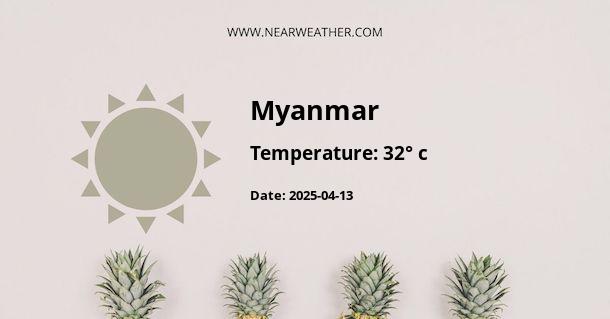Climate and Weather in Union of Burma (Myanmar)
The Union of Burma, also known as Myanmar, is a country located in Southeast Asia. It is known for its diverse landscape, rich cultural heritage, and historical landmarks. The climate in Myanmar is influenced by its geographical location, with different regions experiencing varying weather patterns throughout the year. Let's take a closer look at the climate and weather in Union of Burma.
Geographical Factors
Myanmar is bordered by several countries, including India, China, Thailand, and Bangladesh. Its geographical location between the Tropic of Cancer and the Equator contributes to its tropical monsoon climate. The country can be divided into three main regions: the coastal areas, the central plain, and the mountainous regions.
Seasonal Weather Patterns
The weather in Union of Burma can be classified into three distinct seasons: the hot season, the rainy season, and the cool season.
Hot Season (March to May)
The hot season in Myanmar usually lasts from March to May. During this period, temperatures can soar, especially in the central and northern parts of the country. Average temperatures can range from 30°C to 40°C (86°F to 104°F). The coastal areas, however, experience slightly lower temperatures due to the cool sea breeze.
Rainy Season (June to October)
The rainy season in Union of Burma spans from June to October. This is when the country receives the majority of its annual rainfall. The southwest monsoon brings heavy downpours, particularly in the coastal and delta regions. The central and northern parts of the country also experience rainfall, but to a lesser extent. The average rainfall during this season ranges from 1,000mm to 5,000mm (39 to 197 inches).
The heavy rainfall during the monsoon season can lead to occasional flooding, especially in low-lying areas. It is important to be aware of weather conditions and heed any warnings or advisories issued by local authorities.
Cool Season (November to February)
The cool season in Union of Burma occurs from November to February. This is considered the most pleasant time to visit the country, as temperatures are milder and the humidity is lower. Average temperatures range from 20°C to 25°C (68°F to 77°F) in most regions, making it ideal for outdoor activities and sightseeing.
Regional Variations
Due to its diverse geography, Myanmar experiences regional variations in climate and weather.
Coastal Areas
The coastal areas of Myanmar, including Yangon and the Irrawaddy Delta, have a maritime climate. This means that temperatures are generally cooler compared to other regions. The coastal areas also receive more rainfall throughout the year, with the rainy season extending further into the year.
Central Plains
The central plains, including Mandalay and Bagan, have a semi-arid climate. These regions experience hot and dry conditions during the hot season, with temperatures reaching their peak. The cool season brings relief from the heat, with pleasant temperatures for outdoor activities.
Mountainous Regions
The mountainous regions of Myanmar, such as the Shan State and the Chin Hills, have a cooler climate due to higher elevations. Temperatures can drop significantly, especially during the cool season, and these areas often experience fog and mist. The mountainous regions also receive more rainfall compared to the central plains.
Climate Change and Future Projections
Like many other countries, Myanmar is also facing the impacts of climate change. Rising temperatures, changing rainfall patterns, and an increase in extreme weather events are some of the challenges the country is currently dealing with.
According to climate projections, Myanmar is expected to experience more frequent and intense heatwaves in the future. The duration of the hot season may also extend, leading to prolonged periods of high temperatures. This can have significant implications for agriculture, water resources, and public health.
Additionally, changes in rainfall patterns may result in more erratic monsoon seasons, with increased risks of flooding and drought. These changes can impact food security, water availability, and livelihoods, particularly for rural communities.
Conclusion
The climate and weather in Union of Burma vary throughout the year and across different regions. Understanding these seasonal patterns and regional variations can help visitors plan their trips accordingly. Whether you prefer the heat of the hot season, the lush greenery of the rainy season, or the mild temperatures of the cool season, Myanmar offers a unique climate experience for every traveler.
A - Myanmar's Latitude is 22.000000 & Longitude is 98.000000.
A - Weather in Myanmar is 21° today.
A - Climate Conditions in Myanmar shows overcast clouds today.
A - Humidity in Myanmar is 44% today.
A - Wind speed in Myanmar is 1.22 km/h, flowing at 350° wind direction. today.
